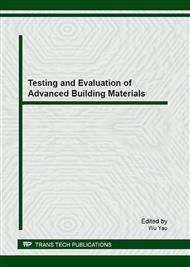p.230
p.235
p.239
p.244
p.249
p.255
p.259
p.266
p.271
Environmentally Friendly Cellular Concrete for Wall Insulation
Abstract:
Cellular concrete characterizes low mass density and low thermal conductivity is one of the durable and economic wall insulation materials which have good market prospects. The present paper investigated the composition of ternary cementitious materials, mixture design and production process of cellular concrete panel (CCP). Experimental results indicated that a higher compressive strength of CCP may be obtained by blended PⅡ52.5 Portland cement with pulverized low temperature clinker (PLWC) made of water treatment sludge and fly ash in the mass ratio of 0.70: 0.15: 0.15. CCP with dry density of 226 kg/m3, thermal conductivity of 0.056 W/ (m•K), compressive strength of 0.6 MPa and water absorption ratio of 7.6 vol. % was modified by high range water reducer, polypropylene fiber and water resistant agent. Mathematic models for controlling temperature of mixing water and for calculation quantity of gas forming admixture were established. Insulated moulds were specially designed for taking advantage of hydration heat of cement to speed up moulds turnover. Meanwhile, internal microcrack of CCP was avoided. CCP incorporating PLWC and fly ash may be used as external insulation material of walls.
Info:
Periodical:
Pages:
271-275
Citation:
Online since:
January 2013
Authors:
Price:
Сopyright:
© 2013 Trans Tech Publications Ltd. All Rights Reserved
Share:
Citation:


